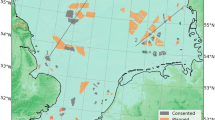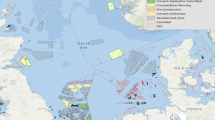Abstract
In the last decades, offshore wind harvesting has increased enormously, and is seen as a renewable energy resource with great potential in many regions of the world. Therefore, it is crucial to understand how this resource will evolve in a warming climate. In the present study, offshore wind resource in the Southwestern African region is analysed for the present and future climates. A ROM (REMO-OASIS-MPIOM) climate simulation in uncoupled and coupled atmosphere–ocean mode, at 25 km horizontal resolution, and a multi-model ensemble built with a set of regional climate models from the CORDEX-Africa experiment at 0.44° resolution were used. The projected changes of the offshore wind energy density throughout the twenty-first century are examined following the RCP4.5 and RCP8.5 greenhouse gas emissions scenarios. Characterised by strong coastal-parallel winds, the Southwestern African offshore region shows high values of wind energy density at 100 m, up to 1500 Wm−2 near the coast, particularly offshore Namibia and west South Africa. Conversely, along Angola’s coast the available offshore wind energy density is lower. Throughout the twenty-first century, for the weaker climate mitigation scenario (RCP8.5), an increase of the offshore wind resource is projected to occur along Namibia and South African western coasts, more pronounced at the end of the century (+ 24%), while a decrease is projected along Angola’s coasts, reaching a negative anomaly of about − 32%. Smaller changes but with the same pattern are projected for the stronger climate mitigation scenario (RCP4.5). The future deployment of offshore floating hub turbines placed at higher heights may allow higher production of energy in this region. Along offshore Namibia and west South Africa, the wind energy density at 250 m showed differences that range between 30 and 50% relative to wind energy density at 100 m.










Similar content being viewed by others
References
Atlas R, Hoffman RN, Ardizzone J et al (2011) A cross-calibrated, multiplatform ocean surface wind velocity product for meteorological and oceanographic applications. Bull Am Meteorol Soc 92:157–174. https://doi.org/10.1175/2010BAMS2946.1
Bakun A, Black BA, Bograd SJ et al (2015) Anticipated effects of climate change on coastal upwelling ecosystems. Curr Clim Change Rep 1:85–93. https://doi.org/10.1007/s40641-015-0008-4
Barthelmie RJ, Pryor SC (2014) Potential contribution of wind energy to climate change mitigation. Nat Clim Change 4:684–688. https://doi.org/10.1038/nclimate2269
Beardsley RC, Dorman CE, Friehe CA et al (1987) Local atmospheric forcing during the coastal ocean dynamics experiment 1. A description of the marine boundary layer and atmospheric conditions over a Northern California upwelling region. J Geophys Res 92:1467–1488
Careto JAM, Cardoso RM, Soares PMM, Trigo RM (2018) Land-Atmosphere coupling in CORDEX-Africa: hindcast regional climate simulations. J Geophys Res Atmos 123:11048–11067. https://doi.org/10.1029/2018JD028378
Carvalho D, Rocha A, Gómez-Gesteira M, Silva Santos C (2014) Offshore wind energy resource simulation forced by different reanalyses: comparison with observed data in the Iberian Peninsula. Appl Energy 134:57–64. https://doi.org/10.1016/j.apenergy.2014.08.018
Christensen OB, Drews M, Christensen JH, Dethloff K, Ketelsen K, Hebestadt I, Rinke A (2007) The HIRHAM regional climate model version 5 (beta). Technical Report 06-17, pp 1–22
EIA (2019) Annual Energy Outlook 2019 with projections to 2050
Fant C, Adam Schlosser C, Strzepek K (2016) The impact of climate change on wind and solar resources in southern Africa. Appl Energy 161:556–564. https://doi.org/10.1016/j.apenergy.2015.03.042
Giorgetta MA, Jungclaus J, Reick CH et al (2013) Climate and carbon cycle changes from 1850 to 2100 in MPI-ESM simulations for the Coupled Model Intercomparison Project phase 5. J Adv Model Earth Syst 5:572–597. https://doi.org/10.1002/jame.20038
Giorgi F, Jones C, Asrar GR (2009) Addressing climate information needs at the regional level: the CORDEX framework. WMO Bull 58:175–183
GWEC (2010) Global wind 2009 report. Brussels
GWEC (2019) Global Wind Report 2018
Hewitson B, Lennard C, Nikulin G, Jones C (2012) CORDEX-Africa: a unique opportunity for science and capacity building. CLIVAR Exch No 60 17:6–7. https://doi.org/https://doi.org/10.1080/13691058.2013.807076
Jacob D, Van Den Hurk BJJM, Andræ U et al (2001) A comprehensive model inter-comparison study investigating the water budget during the BALTEX-PIDCAP period. Meteorol Atmos Phys 77:19–43. https://doi.org/10.1007/s007030170015
Kaldellis JK, Kapsali M (2013) Shifting towards offshore wind energy-Recent activity and future development. Energy Policy 53:136–148. https://doi.org/10.1016/j.enpol.2012.10.032
Kalognomou EA, Lennard C, Shongwe M et al (2013) A diagnostic evaluation of precipitation in CORDEX models over Southern Africa. J Clim 26:9477–9506. https://doi.org/10.1175/JCLI-D-12-00703.1
Kim J, Waliser DE, Mattmann CA et al (2014) Evaluation of the CORDEX-Africa multi-RCM hindcast: systematic model errors. Clim Dyn 42:1189–1202. https://doi.org/10.1007/s00382-013-1751-7
Lima DCA, Soares PMM, Semedo A, Cardoso RM (2018) A global view of coastal low-level wind jets using an ensemble of reanalyses. J Clim 31:1525–1546. https://doi.org/10.1175/JCLI-D-17-0395.1
Lima DCA, Soares PMM, Semedo A et al (2019a) How will a warming climate affect the Benguela coastal low-level wind jet? J Geophys Res Atmos 124:5010–5028. https://doi.org/10.1029/2018JD029574
Lima DCA, Soares PMM, Semedo Á et al (2019b) A climatological analysis of the Benguela coastal low-level jet. J Geophys Res Atmos 124:3960–3978. https://doi.org/10.1029/2018JD028944
Lu X, McElroy MB, Kiviluoma J (2009) Global potential for wind-generated electricity. Proc Natl Acad Sci USA 106:10933–10938. https://doi.org/10.1073/pnas.0904101106
Moss RH, Edmonds JA, Hibbard KA et al (2010) The next generation of scenarios for climate change research and assessment. Nature 463:747–756. https://doi.org/10.1038/nature08823
Nikulin G, Jones C, Giorgi F et al (2012) Precipitation climatology in an ensemble of CORDEX-Africa regional climate simulations. J Clim 25:6057–6078. https://doi.org/10.1175/JCLI-D-11-00375.1
Nogueira M, Soares PMM, Tomé R, Cardoso RM (2019) High-resolution multi-model projections of onshore wind resources over Portugal under a changing climate. Theor Appl Climatol 136:347–362. https://doi.org/10.1007/s00704-018-2495-4
OECD/IEA (2013) Technology Roadmap. Wind energy
Panitz HJ, Dosio A, Büchner M et al (2014) COSMO-CLM (CCLM) climate simulations over CORDEX-Africa domain: analysis of the ERA-Interim driven simulations at 0.44° and 0.22° resolution. Clim Dyn 42:3015–3038. https://doi.org/10.1007/s00382-013-1834-5
Pryor SC, Barthelmie RJ (2011) Assessing climate change impacts on the near-term stability of the wind energy resource over the United States. Proc Natl Acad Sci 108:8167–8171. https://doi.org/10.1073/pnas.1019388108
Ranjha R, Svensson G, Tjernström M, Semedo A (2013) Global distribution and seasonal variability of coastal low-level jets derived from ERA-Interim reanalysis Global distribution and seasonal variability of coastal low-level jets derived from ERA-Interim rean. Tellus A Dyn Meteorol Oceanogr 65:1–21. https://doi.org/10.3402/tellusa.v65i0.20412
Reboita MS, Amaro TR, de Souza MR (2018) Winds: intensity and power density simulated by RegCM4 over South America in present and future climate. Clim Dyn 51:187–205. https://doi.org/10.1007/s00382-017-3913-5
Riahi K, Rao S, Krey V et al (2011) RCP 8.5—a scenario of comparatively high greenhouse gas emissions. Clim Change 109:33–57. https://doi.org/10.1007/s10584-011-0149-y
Rockel B, Will A, Hense A (2008) The regional climate model COSMO-CLM (CCLM). Meteorologische Zeitschrift, August 25
Samuelsson P, Coauthors (2011) The rossby centre regional climate model rca3: model description and performance. Tellus Ser Dyn Meteorol Oceanogr 63:4–23. https://doi.org/10.1111/j.1600-0870.2010.00478.x
Sein DV, Mikolajewicz U, Gröger M et al (2015) Regionally coupled atmosphere-ocean-sea ice-marine biogeochemistry model ROM: 1. Description and validation. J Adv Model Earth Syst 7:268–304. https://doi.org/10.1002/2014MS000357
Semedo A, Soares PMM, Lima DCA et al (2016) The impact of climate change on the global coastal low-level wind jets: EC-EARTH simulations. Glob Planet Change 137:88–106. https://doi.org/10.1016/j.gloplacha.2015.12.012
Soares PMM, Cardoso RM, Semedo Á et al (2014) Climatology of the Iberia coastal low-level wind jet: weather research forecasting model high-resolution results. Tellus Ser A Dyn Meteorol Oceanogr 66:1–18. https://doi.org/10.3402/tellusa.v66.22377
Soares PMM, Lima DCA, Cardoso RM et al (2017a) Western Iberian offshore wind resources: more or less in a global warming climate? Appl Energy 203:72–90. https://doi.org/10.1016/j.apenergy.2017.06.004
Soares PMM, Lima DCA, Cardoso RM, Semedo A (2017b) High resolution projections for the western Iberian coastal low level jet in a changing climate. Clim Dyn 49:1547–1566. https://doi.org/10.1007/s00382-016-3397-8
Soares PMM, Lima DCA, Semedo A et al (2019a) Assessing the climate change impact on the North African offshore surface wind and coastal low-level jet using coupled and uncoupled regional climate simulations. Clim Dyn 52:7111–7132. https://doi.org/10.1007/s00382-018-4565-9
Soares PMM, Lima DCA, Semedo Á et al (2019b) The North African coastal low level wind jet: a high resolution view. Clim Dyn 53:1211–1230. https://doi.org/10.1007/s00382-018-4441-7
Sydeman WJ, García-Reyes M, Schoeman DS et al (2014) Climate change and wind intensification in coastal upwelling ecosystems. Science 345:77–80. https://doi.org/10.1126/science.1251635
Talley LD, Pickard GL, Emery WJ, Swift JH (2011) Descriptive physical oceanography: an introduction, 6th edn. Academic Press, Cambridge
Tang W, Liu WT, Stiles BW (2004) Evaluation of high-resolution ocean surface vector winds measured by QuikSCAT scatterometer in coastal regions. IEEE Trans Geosci Remote Sens 42:1762–1769. https://doi.org/10.1109/TGRS.2004.831685
Van Meijgaard E, Van Ulft LH, Van De Berg WJ, Bosveld FC, Van Den Hurk BJJM, Lenderink G, Siebesma AP (2008) The KNMI regional atmospheric climate model RACMO version 2.1
van Vuuren DP, Edmonds J, Kainuma M et al (2011) The representative concentration pathways: an overview. Clim Change 109:5–31. https://doi.org/10.1007/s10584-011-0148-z
Wang D, Gouhier TC, Menge BA, Ganguly AR (2015) Intensification and spatial homogenization of coastal upwelling under climate change. Nature 518:390–394. https://doi.org/10.1038/nature14235
Winant CD, Dorman CE, Friehe CA, Beardsley RC (1988) The marine layer off northern California: an example of supercritical channel flow. J Atmos Sci 45:3588–3605
WindEurope (2019) Wind energy in Europe in 2018—Trends and Statistics
Wiser R, Yang Z, Hand M, et al. (2011) Wind energy. In: In IPCC special report on renewable energy sources and climate change mitigation. Cambridge University Press, Cambridge and New York
Wiser R, Bolinger M, Barbose G, et al. (2018) 2018 Wind technologies market report
Yamada T, Mellor G (1975) A simulation of the Wangara atmospheric boundary layer data. J Atmos Sci 32:2309–2329. https://doi.org/10.1175/1520-0469(1975)032%3c2309:ASOTWA%3e2.0.CO;2
Acknowledgements
Daniela Lima is supported by FCT through a doctoral grant PD/BD/106008/2014, within the EarthSystems Doctoral Program of the Faculty of Sciences of the University of Lisbon. The work on this study was pursuit in the framework of the SOLAR project (PTDC/GEO-MET/7078/2014) and LEADING project (PTDC/CTA-MET/28914/2017), financed by the Portuguese Foundation for Science and Technology. This work was also supported by FCT through project UIDB/50019/2020—Instituto Dom Luiz. Dmitry Sein is supported by the EC Horizon 2020 project PRIMAVERA under the grant agreement 641727 and the state assignment of the Ministry of Science and Higher Education of Russia (theme 0149-2019-0015). The model simulation was performed at the German Climate Computing Center (DKRZ). The authors also thank the climate modelling groups (listed in Table 1) for producing and making available their model output, available in the Portal Earth System Grid Federation (http://esg-dn1.nsc.liu.se/esgf-web-fe/live).
Author information
Authors and Affiliations
Corresponding author
Additional information
Publisher's Note
Springer Nature remains neutral with regard to jurisdictional claims in published maps and institutional affiliations.
Rights and permissions
About this article
Cite this article
Lima, D.C.A., Soares, P.M.M., Cardoso, R.M. et al. The present and future offshore wind resource in the Southwestern African region. Clim Dyn 56, 1371–1388 (2021). https://doi.org/10.1007/s00382-020-05536-4
Received:
Accepted:
Published:
Issue Date:
DOI: https://doi.org/10.1007/s00382-020-05536-4




